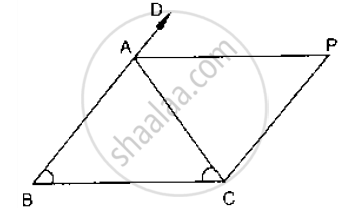Advertisements
Advertisements
प्रश्न
ABCD is a parallelogram in which diagonal AC bisects ∠BAD. If ∠BAC = 35°, then ∠ABC =
विकल्प
70°
110°
90°
120°
उत्तर
ABCD is a parallelogram in which AC bisects ∠A.

It is given that ∠BAC = 35°
Therefore,
∠BAD = 2(∠BAC)
∠BAD = 2(35°)
∠BAD = 70°
Since, DC || AB
Therefore,
∠BAD + ∠ABC = 180°
70° +∠ABC = 180°
∠ABC = 110°
Hence, the correct choice is (b).
APPEARS IN
संबंधित प्रश्न
ABCD is a square. AC and BD intersect at O. State the measure of ∠AOB.
The sides AB and CD of a parallelogram ABCD are bisected at E and F. Prove that EBFD is a parallelogram.
P and Q are the points of trisection of the diagonal BD of a parallelogram AB Prove that CQ is parallel to AP. Prove also that AC bisects PQ.
In a ΔABC median AD is produced to X such that AD = DX. Prove that ABXC is a
parallelogram.
In Fig. below, AB = AC and CP || BA and AP is the bisector of exterior ∠CAD of ΔABC.
Prove that (i) ∠PAC = ∠BCA (ii) ABCP is a parallelogram

In a parallelogram ABCD, if ∠D = 115°, then write the measure of ∠A.
In a parallelogram ABCD, if ∠A = (3x − 20)°, ∠B = (y + 15)°, ∠C = (x + 40)°, then find the values of xand y.
In a parallelogram ABCD, the bisector of ∠A also bisects BC at X. Find AB : AD.
We get a rhombus by joining the mid-points of the sides of a
Prove that the quadrilateral formed by the bisectors of the angles of a parallelogram is a rectangle.
